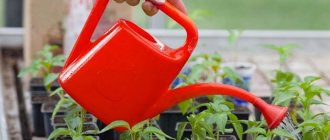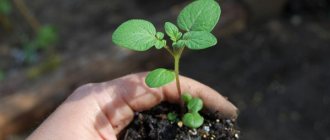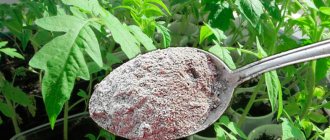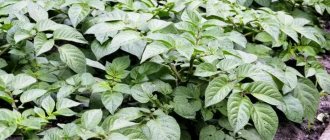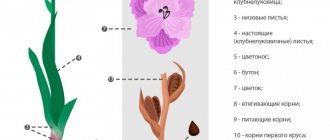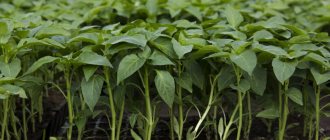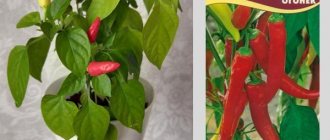The vagaries of an overseas vegetable
Growing peppers is not too different from other crops. There is only one nuance - bell peppers are capricious. He doesn't like weather changes. He needs a stable air temperature. The plant is difficult to tolerate picking and transplanting. His growth is slowing down. When starting to sow bell pepper seedlings, you should carefully study all the recommendations. Simple rules will help you grow a rich harvest by figuring out how to properly plant pepper seedlings.
Seed disinfection
Disinfection is the prevention of diseases and pests. A superficial infection may persist on the seeds. To avoid infection of seedlings, before sowing it is necessary, as the specialist assures, to treat the seeds.
— There are several solutions that are used to disinfect seeds. The most popular “old-fashioned” method is a solution of potassium permanganate. It is important that the concentration is correct - 1-1.5%. To get, for example, a 1% solution, you need 1 tsp. dilute potassium permanganate (which is 6 g) in 600 ml of water. Next, put the seeds in cheesecloth and lower them into liquid for 10-15 minutes. After this, they need to be thoroughly rinsed and dried. It is important to carry out this manipulation after soaking the seeds. If you treat dry ones with potassium permanganate, you can burn them.
Another very popular disinfection method is a hydrogen peroxide solution. There is an opinion that this technique is not entirely effective. Our expert dispelled the myths once or twice.
- In fact, this method showed itself to be excellent in practice. There is one thing! It works against superficial infections. If harmful objects are hidden inside, nothing will help the seeds. To process the seeds, place them in undiluted 3% hydrogen peroxide for 15-20 minutes. By the way, ordinary brilliant green is also suitable for disinfection (1 ml of 1% pharmaceutical solution per 100 ml of water). The most important thing after these procedures is to thoroughly rinse the seeds under running water and dry them.
Sowing time
The dates when to sow pepper seedlings are important. It depends on them whether the crop will have time to gain strength for transplanting to the garden bed. Each plant has its own growth rate. Therefore, it is necessary to strictly observe the timing of planting bell pepper seedlings. When to plant pepper seedlings depends on the variety.
There are varieties:
- Early ripening - ripening period 90-120 days.
- Mid-ripening - ripening period 120-140 days.
- Late - ripening period of 150 days or longer.
The time spent on the windowsill should be enough for the vegetable to ripen for seedlings; the timing is also related to the variety. For early ripening varieties it is 55-65 days. Mid-season varieties are replanted at the age of 65-70 days. For later ones, this figure increases to 70-80 days. Based on these data, each gardener decides for himself when to sow pepper seedlings.
It’s easy to calculate when to sow sweet peppers:
- It will take 3 days to prepare the seeds;
- From 4 to 10 days the first shoots will sprout;
- Picking and recovery will take 10 days;
- plus growth time - depending on the variety.
As a result, it turns out that seedlings are planted approximately three months before the intended transplant to the garden. There is no exact data on what month to start the first sowings. In different climatic zones, the timing of sowing seedlings will differ. When to sow? To determine the exact time, you need to calculate in reverse order. We take the approximate day of transplanting to the garden bed and count the time back. Sowing pepper seedlings in central Russia takes place in the last ten days of February or in the first ten days of March.
In the southern and northern regions, the timing of sowing pepper seedlings will be different. The ripening period of the variety is indicated on the seed package. Sometimes gardeners try to time the planting of seeds to coincide with the phases of the moon. These dates are described in gardeners' reference books. In 2019, the most favorable days to sow vegetables for seedlings were March 17th and 26th. What dates will be successful in other years will be indicated by the gardener's reference book.
When the seedlings are ready to plant
You can move seedlings into open ground at the stage of warming it up to +14...+16 degrees. In this case, there should be no threat of return frosts. Usually the procedure is carried out at the end of May or at the beginning of June.
To make the plant more resistant to the influence of stress factors, you need to start hardening off the bushes 12-14 days before transplanting. To do this, the containers should be taken out into fresh air. Every day you need to increase the time the plants spend outside. It is recommended to start with 20 minutes. 2 days before planting, the bushes should be left in the fresh air overnight.
To ensure a successful planting, it is important to follow the step-by-step process. In this case, the bushes should reach 17-20 cm and have 7-10 high-quality leaves. They should look fairly strong.
The step-by-step process of planting bushes looks like this:
- Dig up and level the beds.
- Add peat and humus to the clay soil.
- Make holes at intervals of 50 cm.
- Add a spoonful of mineral fertilizer to each hole.
- Plant the seedlings directly with a lump of soil.
- Fill the hole halfway and pour out a third of the bucket of water.
- After the liquid has been absorbed, fill the hole to the top with soil.
Important! Before planting, seedlings must be thoroughly watered. This helps reduce the risk of root damage.
When the seedlings are strong enough, they can be transplanted into open ground.
How to prepare planting material
How to plant pepper seedlings correctly: first you need to prepare the seeds. The germination of grains and the health of the plants depend on the correct preparation.
There are several ways to prepare:
- warming up;
- pickling;
- soak.
Warming up
Before sowing pepper seeds for seedlings, they need to be warmed up. Planting material is stored at low temperatures. Otherwise, it will begin to sprout. But the “sleepy” seeds will grow slowly. In order for the plantings to germinate faster, the seeds are kept warm for some time. To do this, they are placed next to heating devices. The best option is a battery. Planting material is placed in gauze bags and tied to the radiator.
The heating temperature is kept at +20-13 degrees. The seeds are heated for three days. For planting pepper seedlings at home, this simple action is of great importance.
Etching
Before planting sweet pepper seedlings at home, the planting material must be disinfected. This is necessary to ensure that the seedlings are not damaged by pests. Spores of harmful fungi and pathogens are found on the surface of the seeds. Planting peppers after dressing reduces the risk of soil contamination. The procedure is carried out in various ways. The simplest is etching with potassium permanganate. The step-by-step process looks like this:
- Stir 1 gram of potassium permarganate in 100 milliliters of warm boiled water. The solution should be pink.
- The seeds are placed in a gauze bag.
- The bag is lowered into the container with the solution.
- After half an hour, the bag should be pulled out and the seeds should be washed.
This is an old way of preparing pepper seedlings at home. Another way to prepare peppers for seedlings is dressing with hydrogen peroxide.
The process looks like this:
- Place the seed in a gauze bag.
- Pour in a 3% hydrogen peroxide solution.
- Keep it for half an hour.
- Rinse well.
These methods of processing planting material are very old. Today there are more effective methods. Before planting seedlings, they are soaked in Fitosporin. The seeds are dipped into the product in a gauze bag. They keep it there for 30 minutes. Then rinse thoroughly. “Alirin” and “Gamair” are used for disinfection. Antiseptic preparations reliably rid seeds of harmful neighbors.
Soak
Moisture and heat have a beneficial effect on plant embryos. Before sowing pepper seedlings at home, the seeds are soaked. There is an old antiquated method of preparing bell pepper seeds for sowing. Take a small plastic jar. A layer of cotton wool moistened with water is placed at the bottom. The grains are laid out on cotton wool. Cover the top with another layer of damp cotton wool. Place the jar in a warm place. After a few days, sprouts appear.
Another long-known method of preparing peppers for planting is aging in ashes. Take half a liter of warm boiled water. 1 tbsp is stirred in it. l. wood ash. Let it brew for 2 days. The seeds are placed in a cloth bag and placed in a glass with infusion. Leave for 5-6 hours. This way the sweet pepper seeds for seedlings will germinate faster.
Preparation can be done differently. Growth stimulants are sold in specialized stores: Epin, Zircon and others. By soaking pepper seeds for seedlings in these compounds, you can quickly obtain high-quality sprouts. Processing pepper seeds for seedlings at home requires patience.
When planning to prepare sweet pepper seeds for seedlings yourself, you need to remember:
- Before planting peppers, do not immerse the seeds in water. Sprouts will not appear in liquid. They need oxygen to develop.
- Whatever composition is used, you need to soak the seeds in cotton cloth or cotton swabs. Sprouts soaked in a gauze bag get stuck in the gaps of the weaving. This causes them great harm.
- To germinate pepper seeds into seedlings at home, you need moisture and air. The best option is to put them on a saucer in cotton swabs and cover the top with plastic wrap. This will reduce water evaporation and retain heat.
- The temperature for germination of peppers for seedlings should be kept at +23-28 degrees Celsius.
- You need to keep the seeds in a home greenhouse for three days.
To properly sow seedlings, you need a lot of patience. Sprouts need attention and care. A good harvest is the patience and work of the gardener.
Creating conditions for the growth of pepper seedlings
It is important not only to plant seedlings correctly, but also to ensure proper care in the future.
Temperature
After pecking the sprouts, the plants need to be moved to a temperature of +15...+17 ºC, in the brightest place (usually a southern or western window sill). Keep it in such conditions for a week. After this period, increase the temperature to +22…+25 ºC (day) and +20 ºC (at night).
Backlight
After the properly planted seeds produce their first leaves, the seedlings are transferred to a well-lit place inaccessible to drafts.
Pepper needs a long day of light of at least 12-14 hours. Therefore, in most cases, the crop requires additional lighting. Otherwise, the seedlings will grow too elongated and thin, with long internodes and sparse foliage.
For additional lighting, you can use fluorescent lamps or phytolamps, or specialized LED devices. Power of light sources per 1 sq. m should be 200 W. Lamps should be located at a distance of 20 cm from the tops of plants. As they grow, light sources are installed higher.
At the stage of formation of cotyledon leaves, the devices must work without stopping for 72 hours. After the appearance of real leaves, the daylight hours are reduced to 14-16 hours. In February, plants are illuminated from early morning (before sunrise) until 19-20 hours in the evening. In April, the lamps are turned on only from 6 am to 12 am and from 4 pm to 7 pm.
Watering and fertilizing
The first 2-3 days after sprouts hatch, they do not need to be watered. As a last resort, if the soil is too dry, you can spray it with a spray bottle.
After the cotyledon leaves open, the seedlings are watered with water +30º. Next, watering is carried out with rain, melted or settled liquid at room temperature. Moisten as the top layer of soil dries out. Avoid dampness, otherwise the root system will begin to rot.
For intensive root development, potassium humate is added (at the rate of 5 ml per 2 liters of water). Before the flower buds begin to form, plants develop slowly, this is normal. During flowering, growth becomes faster. During this period, complex mineral mixtures must be added.
Pinching
When growing peppers at home, you need to pinch them. That is, removing the growth point. This will stimulate the development of the root system and the growth of stepsons from dormant buds in the internodes. Later, flowers appear from them.
You can start pinching when the seedlings begin to actively grow. It is necessary to remove part of the bushes that is located above the 4-6th internode. After some time, the stepchildren will begin to grow. To regulate their number, you need to carry out pinching. Leave 4-6 stepsons (the strongest and strongest). There is no need to remove them in the lower internodes.
Hardening
This process is very important for the further development of seedlings.
The seedlings spend a long time in the house, where it is warm and comfortable conditions for growth. If seedlings are abruptly transferred to open ground or even to an unheated greenhouse, where there are temperature changes, the seedlings may experience stress after transplantation.
It needs to be prepared gradually:
- Transfer the seedlings outside for half an hour, into a greenhouse, or onto a balcony.
- Increase your stay time every day.
Important: In rainy weather or frost, hardening cannot be carried out.
Which soil to choose
Among the recommendations on how to plant pepper seedlings correctly, soil is not the least important. Planting peppers requires light and loose soil. In such a substance it is easier for sprouts to break through to the light. The composition of the soil must be sufficiently nutritious. Young shoots are in dire need of minerals. To plant seeds for seedlings, you need low-acid or neutral soil.
When wondering how to plant sweet pepper seedlings, the gardener needs to think about the land. It can be made from available components.
Includes:
- garden soil is the basis of the soil;
- peat – mineral additive;
- perlite – providing drainage;
- coconut substrate - nutritional composition;
- river sand is necessary for looseness.
Sometimes gardeners are interested in whether it is possible to add mineral fertilizers to the substrate. When sowing seedlings, you should not do this. The seedlings will quickly grow in height. Having reached a certain size, they will begin to bow to the ground, and then simply lie down. Sometimes gardeners simply use coconut substrate to sow pepper seeds. This method is risky. First you should try it on a few seeds and only then make a larger batch.
Before growing seedlings, the soil must be disinfected. It is heated strongly in a microwave or oven. Sometimes the soil is treated with a solution of potassium permanganate. You can spill it with “Fitosporin” or “Previkur”. The instructions clearly describe how to work with these drugs. For planting seedlings, a ready-made substrate is used. It is sold in specialized departments. The soil mixture is well balanced and ready for use.
Possible problems with seedlings and solutions
It is absolutely not difficult to grow pepper seedlings at home yourself. However, due to inexperience, novice gardeners may encounter some nuances.
| Problem | Cause | How to fix |
| The pepper does not germinate well, or the seeds have not sprouted | Poor quality seed material; low soil and air temperatures; deep seeding | Before sowing, test for germination; increase t to +27; spill the soil with a growth stimulator; when sowing, bury the seeds no more than 1 cm |
| Slow seedling growth | Insufficient lighting; lack of nutrition; poor soil; waterlogging | Provide plants with additional light; do regular feeding; balance watering |
| Pulling seedlings | Insufficient lighting; early disembarkation was carried out | Reconsider the disembarkation dates; increase daylight hours; reduce the room temperature |
Sometimes young and tender pepper seedlings can be affected by diseases:
Blackleg
The disease most often affects peppers in the cotyledon leaf stage. The sprouts become yellow, and the subcotyledonous stem near the ground becomes dark. After a while, a black constriction forms on it. The seedlings die. The disease is provoked by excess moisture, sudden temperature changes, and excessively warm growing conditions.
Gray rot
Gray spots appear on the leaves of pepper seedlings. The causes of gray rot on a plant can be excessive watering and keeping seedlings for a long time at low temperatures.
For prevention, peppers are treated with manganese every ten days. Fungicides are used for treatment.
Which container is better for planting
Containers for planting are of great importance in the question of how to sow peppers correctly. If the gardener is going to pick plants, then they can be sown in a common container. To do this, use a box made of boards. A plastic container will do just fine. Seedlings are planted in cells or cups.
Seeds are planted immediately in large cups in cases where picking is not intended. The size of one container is half a liter. Plant strictly in containers with drainage holes.
Each planting method has its positive and negative sides:
- Planting pepper seedlings in plastic cups is a reusable use of a permanent container. The seedlings are not injured during extraction. The container is cheap. The disadvantage of planting sweet pepper seedlings this way: there is no good drainage, it is difficult to transport, the container is unstable, a tray is needed for the cups.
- Planting pepper seeds in a plank box means longevity. You can put together the box yourself. It is convenient to transport. There are disadvantages to sowing pepper seedlings in a box. The box is difficult to carry. When planting pepper seedlings in beds, there is a risk of damage to the roots. The box is used only for the first sowing. When picking, plants are planted in separate containers.
- Sowing pepper seedlings is possible in plastic cassettes. They are equipped with drainage holes. Plastic cells are sold in stores. They have a tray to collect moisture. They are closed with a lid. They are light. It is convenient to remove seedlings from them. Placing pepper seedlings in cassettes also has disadvantages. Tara is short-lived. It is inconvenient to transport plants in it.
- It is good to sow the seeds in peat cups. They are made from peat and cardboard. They are convenient for picking. When replanting, the roots of the plants are not damaged. After sowing, the plant does not need to be pulled out. It is buried in the ground along with the glass. When planning to sow pepper seedlings in peat cups, you should remember that the moisture in them evaporates extremely quickly. Plants will have to be watered frequently. Excess water leads to mold formation. And the cups are not cheap.
How to sow pepper seedlings correctly - there is no ready-made solution. Everyone chooses what is closest to them. When replanting, the roots of the plants are not damaged.
Sowing seeds in peat pots
When sowing peppers in peat pots, you should carefully consider the choice of soil. It should be nutritious, light, moisture-intensive and have normalized acidity. You can use special soil for growing seedlings of nightshade crops, which promotes the stable growth of strong and healthy seedlings.
Place the peat pots in a plastic container, fill them with soil and water with settled water at room temperature. When the water is absorbed, spread the seeds and sprinkle with prepared soil (layer thickness - 1 cm).
Loosely cover the container with the pots with a lid and place in a warm place for germination.
How to plant pepper seedlings correctly
If you want to know how to properly plant pepper seeds for seedlings, remember a number of rules. Plants grow and develop. As they grow, they take up more space. Therefore, they must be sown while maintaining a distance. If you plant pepper seedlings at home close to each other, the sprouts will not have enough light. They will begin to stretch upward. Crowding will lead to plant infection with diseases.
How to sow peppers correctly? Seedlings are planted at a distance of two centimeters from each other. Between the rows leave three to five centimeters.
Sometimes gardeners deny the need for diving. They are sure that there is no better way than to plant pepper seedlings in cups. The glasses are placed on the windowsill. The distance between them is left 3-5 cm.
Why do you need seedlings to grow peppers?
It is almost impossible to grow peppers in Russia without first obtaining seedlings due to the rather harsh climatic conditions. Even in the south of the country it can be too cool to sow seeds directly into open ground.
In addition, the crop may not have time to ripen before the first frost, which may occur as early as September. Because of this, various fungal diseases develop and the fruits spoil right on the bushes.
In addition, in the spring there is not enough sun for the seeds to germinate immediately in the beds. That is why the seedling method of growing is a priority.
How to plant correctly
Beginning gardeners are worried about what depth to plant pepper seeds for seedlings. Pepper seedlings at home are planted to a depth of 1 cm. This depth is sufficient for rooting of sprouts. Some gardeners disagree with this. They bury the seeds one and a half centimeters deep. But the latest scientific data recommend planting exactly 1 cm.
The planting procedure is the same for all vegetable crops:
- Fill the selected container with prepared soil.
- Soak with warm water.
- Wait until the water is absorbed and the earth settles.
- Form furrows 1 cm deep, placing them at a distance of 3-5 cm from each other.
- Spread the seeds every 2 cm.
- Cover with soil.
- Cover the container with plastic wrap. If using a plastic container, cover with a plastic lid. This will create a greenhouse effect.
- Until the first shoots appear, seedlings should be kept in a dark place. A kitchen cabinet is quite suitable for this purpose. The temperature should be maintained at +25-27 degrees.
When shoots appear, the containers need to be moved to a well-lit place. Most often this is a window sill. The temperature is maintained at +20-22 degrees during the day and +14-16 at night. Pepper develops in short daylight conditions. 9-10 hours of sunlight is enough for him. Since the deadline for planting seedlings is the beginning of April, the optimal location for placing the seedlings is a south window. The western and eastern sides will do. On the northern window the air temperature is lower. Sprouts develop more slowly.
You need to water the sprouts when the top layer of soil has dried. Water for irrigation should be heated to +25-30 degrees.
Grown plants should be replanted. This vegetable does not tolerate root damage well. Plants must be picked and planted carefully. Further care is no different from previous actions.
It is important to ensure:
- availability of light for 9-10 hours;
- constant temperature;
- moisture control.
Fertilizing is needed when plants look stunted.
Sowing in peat humus tablets
Before use, place peat humus tablets in any shallow container or special greenhouse with cells. Place the tablets with the indentation facing up and fill them with warm water, after which they will swell and their height will increase 6-7 times.
Before spreading the seeds, the recess in the tablet can be enlarged. This is especially important for sprouted seeds
After sowing, sprinkle the pepper seeds with a small amount of soil, cover with a lid to prevent the tablets from drying out, and place the container in a warm place. The optimal germination temperature for pepper seeds is 23-25°C. After germination, remove the lid and move the container to a well-lit place. In this case, the air temperature can be lowered to 20-22°C.
When is it time to go to the garden?
Half a month before transplanting into the ground, hardening is carried out. This procedure helps to avoid stress in new conditions. To do this, containers with peppers are left on the balcony.
The timing of planting peppers in beds is as vague as the timing of planting pepper seedlings. Each region has its own. The heat-loving vegetable is transplanted into the garden when frost is no longer expected. By this time, the plant should have developed a root system, and 6-8 leaves should appear on the stem.
Gardeners are interested in how long it will take to plant sweet vegetables in the garden beds.
It all depends on the location:
- In the southern regions of our country this is done at the end of April.
- In the middle zone, transplantation is postponed until the second half of May.
- In the Urals and Siberia the deadline is pushed back to the end of May. Sometimes the process drags on until early June.
The process of transplanting into the ground is ordinary. It is shown in the photo. Planting material grown properly at home is stronger. Plants quickly take root in open soil and produce excellent harvests. The gardener sees their development throughout the entire growth period. He is able to make adjustments. The work invested in growing seedlings will pay off with a good harvest.
- Feeding pepper seedlings for growth at home
- New varieties of hot peppers: review of the year
- New varieties of sweet peppers with descriptions: review of the year
- How quickly do sweet peppers sprout after sowing?
Tips for sowing and growing
Sowing seeds is carried out in different ways - it all depends on the desired number of seedlings and the available conditions for its maintenance.
When using boxes or containers, the general container is filled with soil with a layer of 3-4 cm and lightly compacted. Grooves are made on the surface and moistened generously with warm water or phytosporin solution. The seeds are placed in grooves with a distance of 2-3 cm, so that during subsequent replanting (picking) it is possible to remove as much soil as possible without damaging the root system. The top of the planting is sprinkled with lighter soil, about 1 cm thick, and moistened again. The container is covered with cling film or glass and left at a temperature of 25...28 ℃, without light.
After the first green sprouts appear, the film is removed, the temperature is reduced to +20 degrees, and after a week it is raised again to 22...25 ℃
To stimulate the root system and prevent the stretching of young plants, it is advisable to create differences between night and day temperatures by at least 2-3 degrees, for example, using a window slightly open at night, but avoiding drafts.
After the first 1-3 pairs of true leaves appear, the seedlings are transplanted (picked) into individual cups. In this case, to fill individual containers, take more nutritious, enriched soil, for example, with the addition of vermicompost (100-200 g per 1 kg of soil) or mature compost (200-300 g per 1 kg).
Often, when picking, the root system is damaged, which leads to a stop in growth for 10-14 days. This can be avoided using another planting method - in cassettes, peat tablets or small (100-200 ml) cups, followed by transferring them 2 or 3 times into larger containers.
With each transshipment, increasing soil fertility is mandatory
I have verified from personal experience: if you use two disposable plastic cups as planting containers, one of which is cut in half lengthwise in advance and inserted into the other, then when replanting the plant can be easily removed from the broken halves along with a lump of earth without damaging the root system.
Also, when growing pepper seedlings, it is important to consider a number of nuances:
- plants grown in cups should not touch each other - competition for light will lead to their intensive stretching;
- the vegetable crop is very demanding when it comes to watering; it reacts to its lack by wilting of the leaves, so it is necessary to focus on the condition of the soil and moisten it approximately once every 3-4 days with water at room temperature;
- peppers are heat-loving plants, the critical air temperature for them is +14 degrees, at lower temperatures the seedlings may die;
- Root feeding should be carried out only with fertilizers specifically designed for seedlings, strictly according to the instructions. However, it is more effective to enrich the soil by transshipment 2-3 times, during which vermicompost is added (initially 10% of the total volume of soil, subsequently - 20%);
- When transplanting pepper, unlike tomatoes, it is not recommended to bury the stem, otherwise the seedlings will lag behind by 2-3 weeks in growth and be more at risk of developing a disease such as blackleg.
When planning further cultivation in a greenhouse, seedlings do not need to be adapted to open ground conditions by pre-hardening
Thus, if you take a responsible approach to growing peppers, following well-known rules and certain nuances of agricultural technology, you can get strong, healthy seedlings, which means you can subsequently reap a rich harvest of tasty, aromatic, healthy fruits.
Choosing a Pepper Variety
For growing on the balcony, I choose ultra-early, early-ripening varieties - dwarf and low-growing peppers that do not grow higher than 50 cm. I will present you varieties that deserve attention:
- Treasure Island. The first harvest will appear in 90-100 days. The fruits are heart-shaped, red-orange, weighing up to 60 g.
- Philippok. Ultra-early (75-80 days) low-growing hybrid. The fruits are cube-shaped, weighing 50-60 g. Very tasty, of various colors - from dark green to bright red.
- Martin. Ripening period – up to 130 days. The peppers are juicy, aromatic, red in color with thick walls, weighing up to 85 g.
- Dwarf. Peppers are ready on the 110th day after planting. The fruits are cone-shaped, fleshy, juicy, red in color. Approximate weight – 80-85 g.
- Kolobok. Low-growing (20-30 cm), early, densely leafed variety. The fruits are smooth, round, with delicate skin and pulp. They stand out for their excellent taste and thick walls. The weight of peppers reaches 100-160 g.
- Gift from Moldova. The harvest ripens 125-135 days after emergence. The peppers are very large “for home production” - weighing up to 90 g. The taste is rich, very sweet, the color of the fruit is dark red.
- Watercolor. The harvest is ready by 110 days from germination. Miniature peppers - up to 30 g. The fruits are glossy, cone-shaped, bright red.
- The firstborn of Siberia. The harvest appears on day 110-115. These are aromatic, extremely tasty peppers of a rich red color. They can even be called gigantic - weighing up to 100 g.
- Sturdy. An early ripening and high-yielding variety. The maximum height of the plant is 35-50 cm. The fruits are smooth, cone-shaped, weighing 70-75 g. The color ranges from yellow to scarlet.
- Winnie the Pooh. Low-growing (up to 30 cm), early-ripening (100-110 days) variety of bell pepper. Produces a cone-shaped harvest weighing up to 70 g. The fruits are red and ripen smoothly. Tolerates thickened plantings well.
As for hot peppers, the following varieties will feel great on the balcony or windowsill:
- Fire Maiden;
- Falcon's Beak;
- Coral;
- Bell;
- Bishop's Crown.
Don’t forget that you can get seeds of your own production - leave 2-3 peppers of the variety you like to ripen.
How to care for peppers when shoots appear
Now the seedlings need to be provided with appropriate “home” care.
It's actually quite simple. You just need to be attentive to peppers and use common sense.
Seedlings should not be placed close to a window (frostbite is possible) or radiators (they dry out the soil and air).
The most important thing is watering. It is necessary to water with moderately warm, settled water. Use a watering can with a spout. A few hours after watering, loosen the soil so that the water does not stagnate.
The seedlings will probably need spraying. You can humidify the air around you. Place a saucer of water among the glasses. This will also increase air humidity.
Feeding will be needed only after picking.
If the seedlings begin to stretch, treat them with a growth regulator. It's a good idea to rearrange the cups of peppers so that each plant gets enough sunlight.
Pests and diseases
Readers often ask questions about what ails peppers. Most often, sweet peppers are affected by diseases such as verticillium (wilt), bronzing (spotted wilt), phytoplasmosis, fusarium, late blight, apical and gray rot, and blackleg.
- Shepherd's purse: cultivation, properties, application
Verticillium is a fungal disease that exists in three forms: brown, green and dwarf, each of which manifests itself in its own way. Since the destruction of pathogens by pesticides on vegetable plants is undesirable, only preventive measures remain: the destruction of all plant residues in the fall and the cultivation of varieties resistant to verticillium.
Phytoplasmosis, or stolbur, is manifested by the fact that the roots of the plant begin to rot, dwarfism develops, the fruits grow small, thin-walled and tasteless, the leaves curl, harden and turn yellow, and as a result the pepper dries out. They carry the disease of leafhoppers. The fight against phytoplasmosis is carried out by treating peppers with Acara at the time of planting and three weeks after it - spraying the vegetable at this stage of development will not cause harm. In addition, it is necessary to regularly loosen the soil on the site and remove weeds.
Fusarium is a fungal disease that causes peppers to turn yellow: the leaves acquire a poisonous yellow color. Diseased specimens are destroyed, and the remaining plants are carefully looked after: watered moderately in the morning, and weeds are not allowed to appear on the site. Keep in mind that next year it is better not to grow pepper in a site infected with fusarium.
Late blight is a common fungal disease that affects peppers and tomatoes. Symptoms of phytosporosis are the formation of hard spots on the fruits that trap the pulp. They destroy pathogens with the drugs Oksikhom, Zaslon, Barrier, but only before the pepper begins to bloom. By the way: hybrid varieties are much less susceptible to disease.
Blackleg affects the root part of the stem of pepper seedlings as a result of too dense sowing and keeping the soil and air at high humidity. Over time, the stem softens and the seedling dies. To avoid the disease of seedlings with blackleg, you should sow the seeds spaciously, pick the seedlings in time and monitor the humidity level in the greenhouse. If you find diseased seedlings, immediately remove them, dry and loosen the soil in which the seedlings grow, and sprinkle it with wood ash. At this stage of plant development, it is permissible to spray seedlings with Zaslona solution in the ratio: 3 caps of the drug per 1 liter of water.
Blossom rot occurs on the plant, oddly enough, in case of lack of moisture and appears as shiny or black deep spots on the fruit. Sometimes the cause of the disease can be excess nitrogen and calcium in the soil. Infected plants are burned, and the rest are sprayed with calcium nitrate.
Gray rot can affect every plant at any stage of development with putrefactive spots and a gray coating of mold. Its appearance is usually provoked by rainy weather. Affected fruits and parts of the plant must be removed, and the bushes in the area must be sprayed with fungicides, if it is not too late.
Signs of bronze wilt, or spotted wilt, appear as brown spots on leaves that take on a bronze or purple hue. These necrotic spots are located mainly along the main vein of the leaves. As a result of the development of the disease, the top of the plant dies, the fruits in the stalk area become covered with green, brown or pale yellow ring spots. To save the harvest, ripe fruits are picked off and the soil is no longer watered. The fungus is destroyed by Fundazol, however, before treating the pepper with a fungicide, weigh again all the pros and cons of such spraying.
Pests that plague peppers include aphids, spider mites, wireworms and slugs. You can help protect the plant from slugs by scattering nut shells, ground hot pepper or mustard powder over the area. You can also place bowls of dark beer here and there, to which shellfish will crawl from all over the area. And do not forget to loosen the soil between rows to a depth of 4-5 cm in the heat.
The larvae of the click beetle, or wireworms, remain in the soil for five years and gnaw on plant roots. To get rid of wireworms, in the fall the soil on the site is dug up, and in the spring, before planting peppers, several baits are placed on the site by burying pieces of sweet root vegetables in the ground and marking these places for yourself. Click beetle larvae will definitely crawl towards these baits. Every two to three days the baits are dug up, the larvae are collected and destroyed.
Spider mites infest plants in dry conditions; they settle on the underside of leaves and suck out the cell sap from them. If you don’t know how to treat peppers against ticks without resorting to insecticides, we offer you a recipe for a solution that is non-toxic to the human body: mix a tablespoon of liquid soap or dishwashing detergent with a glass of finely chopped onion or garlic, as well as chopped dandelion leaves in 10 liters of water, let it brew and spray the pepper with this mixture at any stage of its development.
Get rid of aphids with wood ash or tobacco dust infused in 10 liters of hot water in the amount of one glass. You can also, if necessary, use a treatment of pepper with a solution of quickly decomposing insecticides such as Karbofos or Keltan at the rate of one tablespoon of the drug per 10 liters of water.
Caring for seedlings immediately after planting until emergence
After sowing the seeds, it is necessary to create conditions conducive to their rapid germination.
The two most important factors are temperature and humidity.
For pepper crops, the ideal temperature is +27 degrees. It is at these indicators on a home thermometer that the grains will sprout the fastest.
The lower the temperature, the longer it will take for seedlings to appear. And at temperatures below +18, the death of all crops is possible.
The appearance of sprouts is impossible without water. Therefore, crops must be constantly kept moist. But you can’t fill it either.
The third factor is access to fresh air. Periodically, the crops must be opened for an hour or two so that they do not turn sour and suffocate.
ON A NOTE. Some gardeners underestimate the importance of light. Therefore, crops do not need to be kept in the dark. The sprouts should reach towards the sun, even if it is artificial.
This regime must be followed for the entire 2 weeks before germination.
As soon as the sprouts hatch, the film cover is removed.
